
 (4 / 5)
(4 / 5)
Funny Girl brings West End’s finest to Cardiff, with a cast and supporting ensemble singers and dancers honed to the highest degree of excellency. Based on the real-life story of actress and comedian Fanny Brice, Funny Girl opened as a musical in 1963 on Broadway, transferring to the West End a year later. For many of us, Barbra Streisand’s performance as Fanny in the film still remains in the memory as one of the shining star performances in theatre history.
All the more credit, then, to Sheridan Smith for taking on and embracing a role that calls for every ounce of energy as well as talent in the current revival which opened in the West End last year. Taking place in and around New York just prior to and following World I, this production is staged in its entirety beneath the proscenium arch of the Ziegfeld Theatre, with settings including Fanny’s dressing room at the theatre, Fanny’s home and various other venues where she performed. It’s a rags-to-riches story of Fanny’s rise to stardom and the rise and fall of the courtship and marriage between the unconventional, quirky Fanny and dishy gambler Nick Arnstein.
Smith has the poignancy and the self-doubt behind Fanny’s jokey façade to a T, bringing a tear to the eyes with her singing of People in Act I and belting out with gusto numbers such Don’t Rain on My Parade, although with a tendency now and then to go over the top. Great duets, too, with Darius Campbell as the inveterate gambler Arnstein, who sits down with alacrity to play poker with Fanny’s mum, the indomitable Mrs Brice, and her mates without realising he has fallen into the hands of experts. Campbell is at his best in that scene and in Act I, but not always convincing in the scenes with Smith in the latter half.
The supporting roles do a huge amount towards making this musical what it is, with real star quality from Rachel Izen as Fanny’s mother and Myra Sands as her friend and fellow poker player Mrs Strakosh and some great rendering of numbers such as If A Girl Isn’t Pretty in the opening scene. The nimble-footed Joshua Lay is a wonderfully emotive Eddie Ryan, the dancer who encourages fanny but gets no encouragement from her as far as their personal relationship is concerned. Lay displays some brilliant and acrobatic tap dancing, while Nigel Barber’s portrayal of the legendary Florenz Ziegfeld is almost surreal in its believability.
The dancers and singers of the ensemble have style and panache, with some high speed numbers, notably Rat-Tat-Tat-Tat in Act II, with choreography which includes a touch of the Irish, backed up in intensely green costumes (St Patrick’s Day et al). As for the music – wonderful, with Jule Styne’s tremendous score arranged for this production by Alan Williams and top rank choreography by Lynne Page.
A feel-good show, this – catch it if you can.
Runs until Saturday 8th July
Music: Jule Styne
Lyrics: Bob Merrill
Book: Isobel Lennart
Director: Michael Mayer
Reviewer: Barbara Michaels
Category Archives: Uncategorized
An interview with Rachel Trezise

The Director of Get the Chance, Guy O’Donnell recently got the chance to chat to writer Rachel Trezise. We discussed her career to date, theatre in Wales, and access to literature/cultural provision.
Hi Rachel great to meet you, can you give our readers some background information on yourself please?
I’m a writer from the Rhondda valley. I’m most well known for winning the inaugural International Dylan Thomas Prize in 2006 with a collection of short stories about life in South Wales called ‘Fresh Apples.’
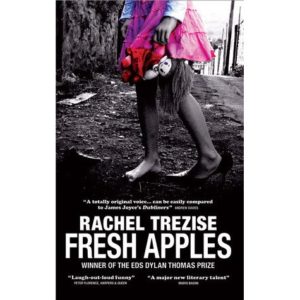
So what got you interested in writing and the arts?
Initially I wanted to be a journalist. I started writing a music fanzine when I was fifteen because I loved music and writing about it so much. Between the time I left school and throughout university I wrote my debut novel in my spare time because I couldn’t wait to start writing for a magazine or newspaper. The novel was published just before I left university and I stuck with writing fiction as well as some freelance journalism.
As a writer you work across a variety of forms from novels, short stories to plays. How do the different disciplines differ for you?
There are different levels of involvement and different amounts of time required to complete each. Short stories are my favourite simply because of their brevity and the fact you needn’t have to hold a whole world in your head which you have to for a novel and to some extent a play. But the writing or the aim of the writing is always the same; to realise each character and their circmstances.
Your first play Tonypandemonium for National Theatre Wales was autobiographical and from a predominantly female perspective. I believe the cast of your next play ‘We’re Still Here’ for NTW is predominantly male and developed from first hand interviews with steelworkers? Can you discuss how this process differs?

Tonypandemonium National Theatre Wales
Credit Mark Douet
Actually it doesn’t differ. Although Tonypandemonium was autobiographical and We’re Still Here is a form of non-fiction both works come via my own world prism. I’ve worked hard to ensure the steelworkers in the play reflect the people I met and spoke to in Port Talbot but I always try to make sure my characters are authentic to their own locality and situation in any case. What is different I suppose is that the characters in We’re Still Here are predominantly male. But they are working class men working in the rapidly-vanishing realm of heavy industry which, much like the de-industrialised setting in Tonypandemonium is an environment that’s underrepresented in literature and theatre. I’ve tried to make the characters as honest and soul-bearing as the men I interviewed and to completely avoid the more common strong and silent male character trope we see everyday in film and on TV.
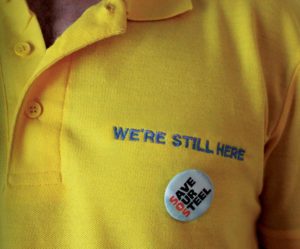
For ‘We’re Still Here’ you are working with Rhiannon White from Commonwealth Theatre. Much of their practice is a socially engaged form of theatre making which has obvious links to NTW’s hugely successful production The Passion with Michael Sheen. Do you feel involving citizen in this way can create new audiences for what can be seen as an elitist art form?

The Creative team on ‘We’re Still Here’ Kully Thiarai, Evie Manning, Rachel Tresize and Rhiannon White
Of course. From start to finish we’ve engaged and will continue to engage with the people of Port Talbot. We’re making a show for the town rather than just about it. In fact Commonwealth Theatre and NTW have set the ticket price lower for residents of Port Talbot which is a very direct way to engage a local and perhaps previously unaccustomed audience and we have a large community cast. NTW worked in a similar way during the run up to Tonypandemonium at the Park and Dare in Treorchy, creating a community cast and inviting the community into rehearsals which gave Treorchy some ownership over the event.
https://www.nationaltheatrewales.org/were-still-here
Get the Chance works to support a diverse range of members of the public to access cultural provision. Are you aware of any barriers to equality and diversity for either Welsh or Wales based artists or specifically writers?
Nothing that isn’t already being identified and addressed but there are always factors that are beyond our control. I loved doing an intensive creative writing workshop with Literature Wales and the South Wales Literature Development Initiative throughout 2013, working mainly with three groups: Young carers, Comprehensive school students and Valleys Kids. All the young people I worked with were eager and receptive but I remember a couple of young people outside one of my Valleys Kids classes who didn’t have the confidence to come in and have a go and whatever I said I couldn’t encourage them because they thought creative writing was somehow academic. I just think it’s a bit of a tragedy that an initiative like that hadn’t reached them a bit earlier in their lives and made the arts seem less threatening.

southwalesliterature.co.uk
There are a range of organisations supporting Welsh and Wales based writers, I wonder if you feel the current support network and career opportunities feel ‘healthy’ to you?
Yes, it does feel healthy to me at the moment. My experience, although more with my literature than with drama work, is that it’s been difficult to get work reviewed widely. The literary quarterlies in Wales are always a few months late, the Welsh newspapers aren’t interested in reviewing the arts in any depth and the national media might not necessarily understand the setting of Wales-based work. (I still remember a headline from The Telegraph the day after I won the Dylan Thomas Prize: ‘Rural tales of despair scoop £60,000.’ I wouldn’t in my wildest dreams describe the post industrial south Wales valleys as ‘rural’.) All these issues make getting your work out there difficult but I know that Get the Chance, Wales Arts Review and NTW have been doing a lot of good work in this area.
If you were able to fund an area of the arts in Wales what would this be and why?
Libraries. My life would be very different had I not discovered Treorchy Library whilst my mother was a cleaner there and I’d like to think that every child has a well-stocked library within walking distance where they can access thousands upon thousands of worlds very different to their own.
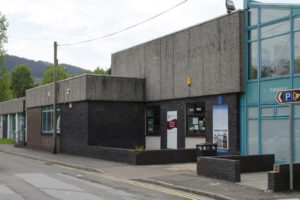
Treorchy Library
What excites you about the arts in Wales? What was the last really great thing that you experienced that you would like to share with our readers?

Work on the script has been manic for the last few months so I haven’t got out much. One thing, which of course it was my duty to see, was an adaptation of one of my own stories ‘Hard As Nails’ by three Treorchy Comprehensive School drama students in association with RCT Theatres and Motherlode. The girls adapted the story, directed and acted in the fifteen minute performance at the Park and Dare and the Millennium Centre. It just made me very proud to have such talented and enthusiastic young people coming straight out of school and diving so fearlessly into the arts.
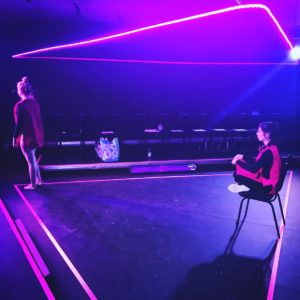
Many thanks for your time
Review Wonder Woman by Jonathan Evans

 (3 / 5)
(3 / 5)
Ever since Man of Steel the DC movies have had to compete with MARVEL as well as distinguish themselves. Unfortunately their idea of distinguishing themselves is to make the image bleak and their Superheroes not so heroic. It has been one failure after another and now comes the time when Wonder Woman is to finally get her own movie. This does not stand on the shoulders of giants and history has been anything but kind to female Superheroes.

This is a glorious time to see your favourite characters from the comic book panel adapted for the big screen. Except if they’re female, of all these recent movies in the last ten years there has been no shortage of female supporting roles that have been well acted and developed, but sadly lacking for being on the title and main focus. So there is indeed a lot riding on Wonder Woman, because it cost hundreds of millions of dollars to make, because DC movies have been consistently poorly received and if this does badly it will probably set female driven action movies back another decade or so.
Firstly who is Wonder Woman? Well she is one of biggest names in the DC universe, her setting is usually mythology and she stands for truth. There are other elements I could get into but lets focus on this, she deserves respect and stands for honesty.
For me Wonder Woman was the best thing in Batman v Superman but maybe that’s because she was only in it for about fifteen minutes. Well luckily it wasn’t just luck, Gal Gadot embodies the character and is able to carry her own movie. She is a stern warrior able to take down any other fighter (with or without superpowers) but is also filled with optimism and compassion seeing the beauty in many things. It’s a tough order to fill I wont lie, but Gadot fills it. She also masters her confidence in her own skin and the costume, embodying absolute nobility.

For the plot we open in modern day with Diana/Wonder Woman looking at an old photograph and how she had intentions of saving the world but something changed. We then cut back to years ago on the island of Themyscira where a great race of women named Amazons live, they don’t interact with the rest of the world and have existed in peace for hundreds of years. This is told to us very beautifully through animation that looks like a moving Peter Paul Rubens painting. The only child on the island is Diana and she grows up with love form her mother Queen Hippolyta and taught the ways of combat by Antiope (Robin Wright). However, one day mans world finds it’s way to Themyscira in the form of pilot Steve Trevor (Chris Pine), he’s on a mission of importance for The Great War. When Diana hears of this she concludes that it must be Ares doing and must now leave her home.
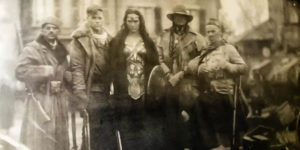
Pine and Gadot make a fine on-screen couple, both are very attractive and the script gives them a lot to work with, from fun subject matters to discuss and the more heavy ones, from etiquette to duty and end goals.

The movies color pallet is varied from setting to setting. Previously the DC movies have drained nearly all the vivid color from their movies in an attempt for you to take them more seriously, it hasn’t worked, they’ve just created something un-engaging to look at. This movie opens with more luscious colors while on Themascira then drains it when we move away from that, this shows a tonal shift for each setting. Plus there are some other settings where it’s a warmer tones. This is a more realised and smart look for a movie.

Being that this is a Superhero in the middle of a World War, fighting soldiers it will inevitable draw comparisons to Captain America: The First Avenger. This isn’t the worst thing for me because I like that movie quite a bit and there’s nothing wrong with channeling a fun tone for your movie watching. However Wonder Woman and Captain America are very different characters and this is still it’s own movie, so no harm no fowl.

This is, without question, the best DC movie to be released since Man of Steel. It is a Superhero movie that knows what a Superhero is, has colour, a consistent tone and a lead character and actor that make you believe in them.
This is not a great movie; there are some basic logic and directorial choice movements that did have me questioning the moment as it played. I wish it was a modern day The Dark Knight, but it’s not. It is however a solidly made movie, with a consistent tone and a message to deliver with a character that gets it right.

For fans of Wonder Woman I’m sure they’ll be satisfied (I was). For others that seek an action, Superhero movie they will get that. For the people that aren’t fans and go to this movie to be convinced, harder to say. I’m sure they will see her appeal and elements of why she is so loved by some. I wouldn’t say this is the highest movie caliber the character is capable of but it does do her justice.
Collaborating with Theatr Clwyd to develop a Welsh critical network

Get the Chance has collaborated with Theatr Clwyd to run a free ‘Get the Chance to be a theatre critic’ workshop and provide free tickets to Theatr Clwyd’s production of The Importance of Being Earnest. The event was supported by Gwennan Mair Jones, Director of Creative Engagement, Theatr Clwyd.
http://www.deeside.com/theatr-clwyds-new-director-creative-engagement-will-promote-power-performing-arts-young-people-wider-community/
Get the Chance was able to run this activity through funding from Arts Council Wales Sharing Together. “A strategic initiative to encourage the development of networking opportunities.”

https://www.theatrclwyd.com/en/whats-on/get-chance-theatre-critic/
12 new critics attended the event ranging in age from 14-80 years. During the workshop we discussed the role of the critic, differing methods of giving critical feedback and the role of the press and marketing department. Many of the those attending are strong advocates for the venue and cultural provision in general. Some of the group attended youth theatre and community engagement workshops at the venue. Some of the group had an education background and had brought young people to see performances in the venue. Some of the older participants have attended performances from the theatres construction in 1976 to the present day.
The participants are all excellent examples of Creative Citizens. Get the Chance is developing a socially engaged, democratic audience development model called Creative Citizens Cymru. Many of the fundamental principles of this model are very similar to the principal goals of the Well-being of Future Generations (Wales) Act.

Some of the reviews for The Importance of Being of Earnest have been posted on the Get the Chance website
getthechance.wales/2017/05/24/review-importance-earnest-theatr-clwyd-elizabeth-lambrakis/
getthechance.wales/2017/05/21/audio-review-importance-earnest-hannah-bywood/
getthechance.wales/2017/05/21/review-importance-earnest-theatr-clwyd-bethany-mcaulay/
getthechance.wales/2017/05/21/review-importance-ernest-theatr-clwyd-karis-alaina-clarke/
It was a very welcome opportunity for Get the Chance to develop its critical network in North Wales. We thank the Arts Council of Wales for funding this opportunity and the support of colleagues at Theatr Clwyd.
All of the participants will earn Spice Time Credits for their time spent volunteering with Get the Chance Wales.
http://www.justaddspice.org/get-involved/get-started-with-time-credits
An online survey has been created to continue some of the conversations raised during the workshops we have been running. If you run a venue or company and are interested in supporting the democratisation of critical networks we invite you to contribute your thoughts to the survey. https://www.surveymonkey.co.uk/r/W27RC3Q
This is the third event Get the Chance has ran through this funding stream, blog posts of the other events can be found below
getthechance.wales/2016/11/26/launch-creative-citizens-cymru-2/
getthechance.wales/2017/01/22/get-chance-takepart/
Guy O’Donnell the director of Get the Chance organised a similar event a few years ago and a blog post on this event can be found at the link below.
http://community.nationaltheatrewales.org/profiles/blogs/critical-feedback-to-the-response-event
An interview with artist Kyle Legall

The Director of Get the Chance, Guy O’Donnell recently got the chance to chat to Kyle Legall. We discussed his career to date, theatre in Wales and his new production RATS (Rose Against the System) which plays at Wales Millennium Centre 02-03 June 2017.
https://www.wmc.org.uk/Productions/2017-2018/other/rats/?view=Standard
“Hi Kyle great to meet you, can you give our readers some background information on yourself please?”
Kyle Legall spray paints Planet Rock, Afrika Bambaataa and the Soul Sonic Force. T-shirt, Higher Graphics.
“I believe you are currently preparing for a new production at The Wales Millennium Centre called RATS (Rose Against The System). I wonder if you can tell us more?”
Kyle was inaugural artist of the year with National Theatre Wales. This information below is taken from Klyle’s blog post on the development process of RATS which was posted on the NTW Community.

Kyle with a RATS cast member
“I will be presenting a glimpse of my Rats project; Rose Against The System. This is an animation I have been working on over the last year. The rats of Butetown have got wise and decide to fight back. I am planning on showing how far I have gotten by trying out a performing version for the first instalment to see if it could work as a theatre piece as well as an animation.”
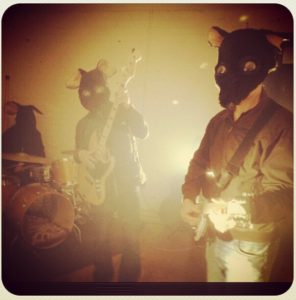
“I have involved local musicians and spoken word talents such as Wibidy and Weller from Degaba. Music score by Dafydd Ieaun, from ‘Catatonia’ and ‘Super Furry Animals’ performing with his new band ‘The Earth’ introducing a new talent I discovered whilst in Edinburgh Fringe, Sam Porter. Guest Voice by Rhys Ifans.”
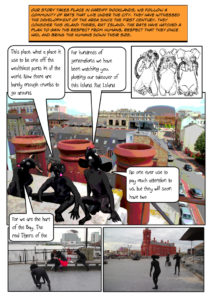
http://community.nationaltheatrewales.org/profiles/blogs/higher-graphics-exhibition-1?xg_source=activity
A live trailer for an earlier version of RATS (Contains strong language)
Voices by Rhys Ifans, Weller, Wibidy, Sciddy, Sam Porter. Music by Dafydd Ieaun from Super Furry Animals
“What was the last really great thing that you experienced that you would like to share with our readers?”
“Many thanks for your time.”
Spice Time Credits- The day I went from Londoner to Tourist

As some of you may or may not know, Get The Chance Wales has a lovely relationship with Spice Time Credits.
As reviewers we earn our credits from our reviews and they can be used for pretty much anything.
Today is my last day in London for a while as I traipse off to America for a bit. As a self confessed Londoner of 2 1/2 years I thought I’d be a tourist for the day and use my Time Credits.
I previously took my parents to the Tower of London – astounded at the money saved and value of experience we got from this.
getthechance.wales/2016/08/17/spending-time-credits-tower-london-hannah-goslin/
Today I saw parts of London I had never seen- views from the MBNA clipper that floated us down the Thames, going crazy fast when water seemed more open – which was tonnes of fun.
The famous Tower Bridge- looking down at the small ant like people below through the glass floor. Queasy feeling this experience but ever so cool none the less.
As most Londoners know – most things are within walking distance. So I trotted up to The Monument. An almost non recognisable statue in a city of architecture, The Monument is to commemorate the Great Fire of London. Inside are 311 steps – and boy does it feel it! While I’m hardly fit, even the fittest struggled but it’s well worth it for the beautiful view at the top and the certificate you get at the end for climbing it.
Finally a short distance away is St Paul’s Cathedral. Well recognised and providing cameos in plenty of TV and films, it is a highlight of London. Inside is ornate and rich, the ceilings phenomenal and gold, with beautiful imagery. To reach the very high up whispering gallery in the main dome, it’s another never ending staircase but very much worth it for what you see.
Time Credits have allowed me to experience parts of London I do not think I ever would have chosen to see on my own and felt like a wonderful reward.
http://www.justaddspice.org/get-involved/get-started-with-time-credits
Review Power Rangers by Jonathan Evans

 (3 / 5)
(3 / 5)
Power Rangers is a franchise that has lasted because it has a tried and tested formula that works. Teenagers get superpower as well as colorful outfits and must defend the earth (or neighborhood) from a galactic threat that then escalates to giant monster vs giant robot.
There have been other movies before, but none have done that well. Now it seems that every studio needs a big franchise under their belt so why not this one?
Kicking off everything is a flashback to prehistoric Earth where colorful warriors lay defeated from a battle, when their armor disintegrates it reveals them to be aliens. One of them stands victorious over the others, this one is named Rita, the last one living, Zordon (Bryan Cranston) orders a meteor to hit earth and buries five colorful coins until the right people can claim them. Cut to present time where the land has become the small town of Angel Grove.
In the town we see a young man named Jason (Dacre Montgomery) attempting a prank that involves the school mascot cow, this goes awry and he is then sentenced to school on Saturday’s just so he can graduate. In this same class there is Billy (RJ Cyler) a possibly autistic kid that is the motormouth and juxtaposes the others with his offbeat ways (probably my favorite). Kimbery (Naomi Scott) a former popular girl but is now in-class and unfriended because she sent a picture and punched out a popular boys tooth (they put it back), later they run into Rini (Becky G) a girl who wander around pretty much and isn’t interested in getting to know the gang, then there’s Zack (Ludi Lin) who also wanders around but is also crazy (cause he tells us so) and more invites himself.
Eventually they do uncover the coins and they get powers and unlock other things and must face the threat, yadda-yadda-yadda.
Clearly the most effort has gone into adding depth to these teenage characters, giving them backstory and trauma and some kind of adversity to tackle. They are all part of a different ethnicity which adds diversity and is more like humanity coming together rather than mostly white people and the token minority.
The thing about all of this is that this is Power Rangers (try saying it out loud). This is by its nature corny, colorful and lighthearted. So they keep in some of the quips and color but when they introduce the dark, edgy elements it doesn’t mesh. A comedic scene can play out and it’s fine, however a dark scene can be pulled-off well but becomes that just happened in a movie where the cheesy things happened it’s like we’re in another movie. Good movies have a theme and tone consistent throughout, they establish if this is for children, teenagers or adults and plays to the kind of mood for said audience. This comes off more unhinged.
Rita Repulsa is the original big villain in the first season of Power Rangers. Here she is given a now look but still taking ques from the original (mostly in the staff) and reworked to be more threatening. The main draw is Elizabeth Banks who decides to go all out in performing her as well as clearly having a lot of fun. It’s hammy, but in a controlled way.
This movie has everything that fans of Power Rangers will expect, but may be not how they’re used to getting it. But even then, does this movie work? It works well enough, it is self aware enough to point out some more obvious cliches and pokes fun of itself enough while clearly being enthusiastic over the source material. For a summer blockbuster for kids and teenagers this is a standard plot with good intention of having a diverse cast. It will do no harm and there are moments where people will be entertained.
Review Zone Play Centre by Kate Richards

Get the Chance has a broad definition of cultural provision. Some of our team are parents or carers and may access theatre, soft play, cinema and leisure facilities. We are also part of the Spice Time Credits network. The Zone play centre supports Spice Time Credit spend.
Out of my Comfort Zone
I have to be honest, when I opened the door of Zone Play Centre on a drizzly Sunday afternoon my heart sank. I’m not a huge fan of indoor soft play centres at the best of times, so the noise that assaulted me and the orange-tinged glow of the artificial lights combined with the total lack of windows, was almost enough to make me turn back…..but breaking a promise to my 3 year old was not an option.
However, first impressions can be wrong. The first positive was the cost – Zone is considerably cheaper than some other options in Cardiff (£4.00 for under 4s compared to £10.50 for the same time in another well-known venue near the city centre).
Zone is also part of the Spice Time Credits Network,costing 2 Time Credits per child.

There is a link to the South East Wales Time Credits Spend brochure below
http://www.justaddspice.org/wp-content/uploads/2017/02/SE-Wales-Spend-Issue-2-2016-Digital-update.pdf
The second positive was the amount of seating and its proximity to the play areas; yes it makes it louder and a bit more cramped, but the grown-ups in our party were able to sit fairly comfortably with a drink, whilst maintaining sight of the children as they played, and this even though it was very busy and had two private parties going on simultaneously.
Our party consisted of 3 adults, two 3 year olds and an 11 month old (who got in for free with his paying older sibling), and I have to say that this was one of the best suited play centres for children of those ages that I have been to. The frames are not so high and so big that the 3 year olds couldn’t cope on their own, or were at risk of going too high and getting stuck out of reach. Even better was the dedicated area for the babies. Most soft plays I have been to have an area for little ones, but often these consist of a ball pit, and some moveable soft blocks or shapes – most of which tend to be still too big or heavy for them to do anything with. Zone however had a basket of small toys (which if necessary you can take back to your table to amuse them whilst you deal with your other little one and supervise snack time or whatever). There was also a play kitchen and wendy house for them to explore as well as the usual soft balls and blocks that you would expect to find in a soft play centre. This section for the very youngest children is located in the middle of the larger frames, so you can sit comfortably in there with the baby, and still see (or be seen) by the pre-schoolers playing on the main frame – ideal for parents coping with two or more children of different ages. Again, whilst at first it seemed a bit cramped and noisy for the little ones to be in the middle of the space – it turned out to be very practical for us.
The other positive for my son, were the cars and bikes. He’s happy to clamber up a play frame and dive down some slides for a period of time, but he will spend hours riding around on a little trike or sitting in a ‘Cosy Coupe’ car, so he was absolutely delighted at the number of those available – even at a peak time on a very busy weekend.
We only bought cold drinks, so I can’t really comment on the refreshments on offer at Zone, but one facility we did make plenty of use of were the toilets. It’s not a pleasant topic, but it’s an important factor for any parent like me, with a recently potty-trained toddler who struggles to prioritise trips to the toilet over playing with his friends, and like most kids of this age can easily misjudge the time it takes to get from the top of a play frame, to Mummy and then on to the toilet, so we were frequent visitors. Again I was pleasantly surprised. Whilst not the most modern facilities I’ve seen, the baby changer had a clean, soft mat on it – and I think there were even wipes available (though those could have been left by another customer I suppose), and in the ladies, there was actually enough space within the cubicles to attend to my 3 year old without me having to train as a contortionist beforehand.
By the end of our visit, whilst pleased to step into daylight and give my ringing ears a rest from the cacophony within, I had to admit, that the kids had a great time, and for young children like ours Zone play centre is very well suited to their needs.
Zone Playcentre
http://zoneplaycentre.co.uk/
Entry prices
Under 8 months Free
9 – 11 Months £1 (Free if accompanied by an older paying child)
1 – 4 Years – £4.00
5 – 12 Years – £5.00
Time restrictions of 2 hours play will apply on busy periods.
Opening Times
Open 7 days a week
Open from 9:15 am to 6pm Monday to Friday
Saturdays 10am to 6pm
Sundays 11am to 5pm from 1st February 2017
No admittance an hour before closing from 1st February 2017
Kitchen Opening Times
Open 7 days a week
Open from 11:00am – 5:00pm Monday to Saturday
Last orders 4.45pm
Sundays from 11.00am – 4.00pm from 1st February
Last orders 3.45pm
Review DenMARKED, Conrad Murray, Battersea Arts Centre by Hannah Goslin
 (4 / 5)
(4 / 5)
Raw. Interesting. Emotional. With a dash of music in the form of looping, beat box. All from one man.
DenMARKED is what can only be described as brilliance. Taken biographically, this one man show from Conrad Murray hits the emotional pedal, pulls the heart strings, but also gives you the giggles. From times of being beaten by his father, his life of constantly being put down and fear of going no where but to rock bottom, however coming out the other side with the help of Shakespeare, music and the arts, we feel as if we are on a roller coaster with him; being able to tell his story is a triumph in itself but to express and tell the tale with such confidence, such theatricality and reflectiveness brings all the different elements to this hour or so long monologue, keeping us interested and the growing sense of friendship with Murray.
Basic use of lighting, pre-recorded narrative titles are used well, not taking away anything from this man, his story, his guitar and loop machine. The music itself is incredible – if this guy was not talented enough with how he has created theatre and ‘performed’ it in such a fantastic way, he continues to shine through the great ‘beats’ he makes on the spot – a CD I would love to own.
DenMARKED parallels parts of Murray’s life with the story of Hamlet, using key quotes to add that little something extra to his message.
With all these elements, this is a clever production and one of a kind – some can do spoken word; some can beat box and use this as a story telling technique; and of course some act. Conrad Murray does all of these, and more, bringing a polished, honest and brave production to the Battersea stage.
https://www.bac.org.uk/content/42636/whats_on/whats_on/shows/denmarked
Review Live Before you Die, Battersea Arts Centre by Hannah Goslin
 (4 / 5)
(4 / 5)
Since coming to the same venue to see Hairspeace last year, I have noticed that there is little (or in my opinion not enough) of performance arts with honesty, in a sort of presentation style.
Walking into Live Before you Die, I was not expecting it to have this theme. But it’s a theme I’m beginning to love.
Live Before you Die is a performance art come presentation of Byron Vincent and Dave McGinn’s journey to fix Byron. With a long standing illness of Bi Polar disorder, this truthful, at times shocking, at others hilarious and brave performance looks into Byron’s disorder, Dave’s friendship and attempts to help and all the crazy, interesting and scary events through this journey.
From meeting American self help professionals, to a stint in Vegas, and a missed show at the Edinburgh fringe, this pair tell their story while bouncing off one another. There’s no fancy tricks, no crazy light and sound moments intervening, no progressive dance; simply two men, in a sort of ‘Pointless’ set up (I’ve got to admit, it was a younger and more interesting similarity to the game show) and video clips of the tale.
This may sound boring – who sees a show that is so minimalist? But do not be fooled – coming from such honesty is definite intrigue and to add all these atmospheric theatrical additions would only ruin what they are achieving. To try and explain such a diverse and complicated illness is hard enough, but to be open and bring your highs, lows and confessions to 40 or so complete strangers takes guts and counteracts the stigma around mental health in a way that I have never seen before or doubt anyone has tried to do.
We are made to feel like friends; we laugh and joke with them, and this relaxed performance isn’t just what we need but we also sense that for Byron and Dave, this is something they need too.
Finishing with a hug from Byron at the end, there’s no certainty of what is next for this pair, but we can be sure their friendship, talent for performance art and more antics are definitely going to continue in abundance. And we hope, positive progression for Byron.
https://www.bac.org.uk/content/42637/whats_on/whats_on/shows/live_before_you_die


